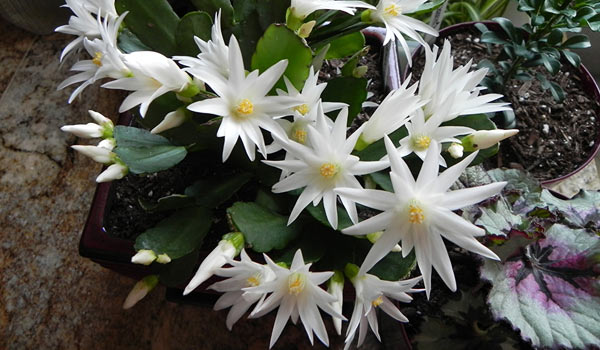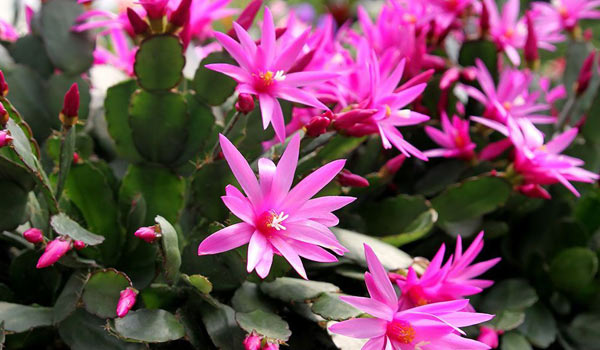Easter Cactus Care (Spring Cactus)

If you see the Easter cactus from a distance, you may have a hard time believing that it belongs to the cactus family. But thanks to Hybridization, we can add a dash of color to any space with the spring cactus and its multiple blooms.
As a hybrid of the Brazilian forest cactus, Easter cactus flowers appear around the Easter holiday (hence the name). Due to the eye-catching flowers and convenient Easter cactus care, beginner and professional gardeners are both interested in growing this plant.
Below, you can find all the information you need to propagate, grow, and care for your own spring cactus.

Knowing the Easter Cactus Better
The Easter cactus (Rhipsalidopsis gaertneri) originally comes from the rainforests of Brazil. It is mostly known for its cheerful blooms that appear in the late winter and spring.
These lovely flowers have an unusual shape, are found in red, pink, orange, peach, lavender, purple, or white. Since these gorgeous flowers bloom during the holiday, the spring cactus is super popular as a holiday gift as well.
When searching for Easter cactus for sale, you’ll notice that they are usually sold in 4, 6, or 8-inch pots. They can grow as tall as afoot. With the right Easter cactus care, they leave for more than 10 years and will be 2 feet tall (and wide).
Unlike a common dessert cactus, the spring cactus don’t have spines. Instead, it has soft, pointed nodes on the edges of its leaves.
Easter Cactus Vs. Christmas Cactus
There are other holiday cacti that you may have heard as well, such as the Thanksgiving and Christmas cactus. What are their differences compared to the spring cactus?
First of all, the Easter cactus is a member of the Rhipsalidopsis. But the Thanksgiving and Christmas cactus are Schlumbergera. Additionally, these two cacti are not tropical and are from drier forests.
Furthermore, as you can guess by their names, Christmas cactus flowers appear around the winter holidays. But as we mentioned, spring cactus blooms from late winter to early spring
However, all of these cacti have flattened stems known as segments (the leaves), which are lightly jagged on the edges.

Easter Cactus Care
Keeping a Rhipsalidopsis gaertneri happy and healthy is not a Herculean task. But if you want your plant to bless you with as many blooms as possible, you should provide a special set of conditions for it.
Spring Cactus Watering
The water needs are similar to many other cacti. Let the Easter cactus soil dry out before each irrigation and when it’s time, water it thoroughly. The pot should have drainage holes so the root doesn’t sit in wet soil and rot. Also, don’t forget to pour the excess water away.
During the late fall to early winter, reduce the watering to encourage the Easter cactus flowers to bloom.
Easter Cactus Soil & Fertilizer
Commercial porous and rich soil mixes for cacti and succulents are the best option for this species. They provide airflow for the plant’s roots and provide its nutrient requirements. To make the soil at home, mix coco coir, peat moss, perlite, and orchid bark.
Spring cactus soil can benefit from regular fertilization. After the blooming period, feed your plant balanced fertilizers (like 10-10-10) every month. Regularly applying compost or other organic fertilizers keeps the Easter cactus soil rich in nutrients, just as the plant prefers.
Spring Cactus Light
This plant grows best in bright natural light with indirect sunlight. As a tropical cactus, it is no stranger to growing in locations that are partly sheltered from the sun; and its fleshy leaves burn by the hot sun. So always pick a bright location with no direct sunlight for your cactus.
Humidity & Temperature
The right humidity and temperature are actually crucial for the Easter cactus flowers to bloom. The spring cactus set buds and blooms in night-time temperatures between 55 to 60 °F (13 to 16 °C).
This cactus enjoys humid environments and will be happy in household humidity levels. So if your home is especially dry, use a humidifier or a pebble tray to provide some extra humidity.
Pro-Tip
To accomplish flowers, stop feeding your spring cactus. Then move it to a location with 12 to 14 hours of darkness with a temperature of 50 °F (10 °C). From October to November, water sparingly. In December, you can move the plant to a warmer location with a 60 to 65 °F range (16 to 18 °C). From February to March, the spring cactus blooms will show up.
Repotting Easter Cactus
This delightful plant likes being pot-bound. So it’s a good idea to repot it every 2 years with a fresh soil mix. It is recommended to repot in the spring after its blooming period.
When repotting, if you noticed that there is still room in the current pot, don’t use a larger container and simply refresh the soil mix. If it’s necessary to change the pot, choose a pot that is 2 to 3 inches wider.
Maintaining & Pruning
If the size of the spring cactus exceeds the largest pot that you prefer, you can prune it after flowering. To reduce its size, prune every year by cutting the outer leaflets back symmetrically.

Spring Cactus Propagation
Using the leaves (stems), you can easily propagate this plant. These are the steps for Easter cactus propagation:
- Twist an at least 3-inch long segment off at the leaf terminal. Be careful not to break the base.
- After separating the leaf, let it harden for at least 48 hours.
- After that, simply stuck it back in shallow, moist perlite.
- Don’t water the leaves until you see the roots sprout (which takes between 3 to 4 weeks).
- After that, you can water it as a mature plant.
The important thing is to start Easter cactus propagation 2 to 3 months after its blooming period.
Easter Cactus Problems
Common pests like mealybugs, scale, and fungus gnats are among Easter cactus problems, but they aren’t the biggest ones. Stem and root rot are bigger problems that wet and heavy soil mixes cause them.
On the other hand, if the Easter cactus leaves are wrinkled, it indicates that your plant is thirsty and the soil is too dry. Although, sometimes it means that the soil is too wet!
If the Easter cactus leaves are falling off, it may be because that the soil is not well-draining at all, improper watering, or that the temperature is too high/low.
Now you have all the information you need for Easter cactus care, all that’s is left to do is bringing one to your house and enjoying the view that it offers with its blooms and flat stems.
- In this post:
- Knowing the Easter Cactus Better
- Easter Cactus Vs. Christmas Cactus
- Easter Cactus Care
- Spring Cactus Propagation
- Easter Cactus Problems



